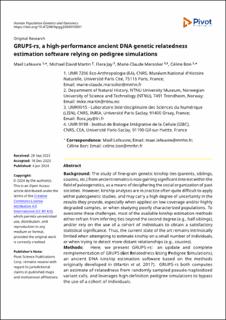| dc.description.abstract | Background: The study of fine-grain genetic kinship ties (parents, siblings, cousins, etc.) from ancient remains is nowgaining significant interest within the field of paleogenetics, as a means of deciphering the social organization of past societies. However, kinship analyses are in practice often quite difficult to apply within paleogenetic studies, and may carry a high degree of uncertainty in the results they provide, especially when applied on low coverage and/or highly degraded samples, or when studying poorly characterized populations. To overcome these challenges, most of the available kinship estimation methods either refrain from inferring ties beyond the second degree (e.g., half-siblings), and/or rely on the use of a cohort of individuals to obtain a satisfactory statistical significance. Thus, the current state of the art remains intrinsically limited when attempting to estimate kinship on a small number of individuals, or when trying to detect more distant relationships (e.g., cousins).
Methods: Here, we present GRUPS-rs: an update and complete reimplementation of GRUPS (Get Relatedness Using Pedigree Simulations), an ancient DNA kinship estimation software based on the methods originally developed in (Martin et al. 2017). GRUPS-rs both computes an estimate of relatedness from randomly sampled pseudo-haploidized variant calls, and leverages high-definition pedigree simulations to bypass the use of a cohort of individuals.
Results: We highlight that GRUPS and GRUPS-rs are especially suitable to perform kinship analysis on a restricted number of ancient samples, and can provide a sufficient statistical significance to estimate genetic relatedness past the second degree, while taking into account user-defined contamination and sequencing error estimates. Importantly, GRUPS-rs offers an estimated 14000-fold speed-up in runtime performance compared to its predecessor — allowing the joint estimation of kinship between dozens of individuals in a matter of minutes — and is now bundled with a user-friendly Shiny interface, in which users can interactively visualize their results.
Conclusions: The GRUPS kinship estimation method is now fully operational in its “GRUPS-rs” implementation, whose use is particularly recommended when analyzing a restricted number of low coverage DNA samples. | en_US |

